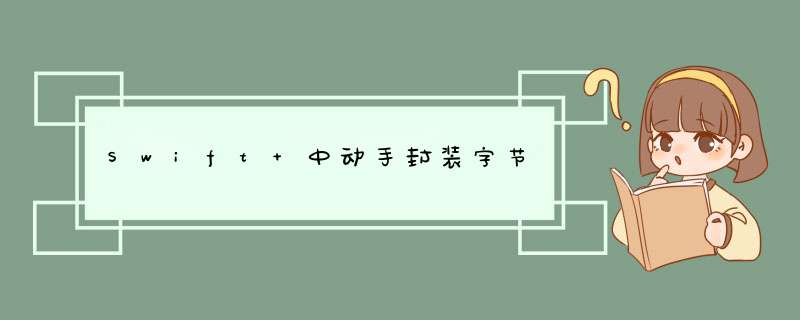
作者:Russ Bishop,原文链接,原文日期:2016-05-12
译者:pmst;校对:walkingway;定稿:CMB
今天,我想尝试封装 float32 类型数据到 SQLite 二进制大对象⌈Binary Large Object (BLOB)⌋ 组中。当然,我可以使用 JsON,protobuf,或是其他一些编码方式。除此之外,NSNumber,NSArray ,NSCoder 和 pList 文件也是不错的选择。
不过,我希望以更加 Swift 的方式来实现,有点类似 C 语言风格,实现迅速且不会引入任何相关性,解码器(decoder)也非常简单,可以在任何平台上实现。
PointerEncoder我们将在 PointEncoder 结构体中实现最终的接口:
struct PointEncoder { // 解码过程中,如果我们得到一个相当大的数值,可以假定为服务器拒绝或是损坏的数据 static let MaxPoints = 1_310_719 // 容量大小 private static let _sizeOfCount = sizeof(Int64.self) // 一个点由两个 float32 类型数据组成,所占内存大小如下 private static let _sizeOfPair = 2 * sizeof(float32.self) static func encodePoints(points: [CGPoint]) -> NSData? { static func decodePoints(data: NSData) -> [CGPoint]} 点数组的最大容量 MaxPoints 被限制在大约 10 MB,这已经远远满足示例中的限定值。试想在移动蜂窝网络或是信号不佳环境下的 WiFi,传递如此数量的点给服务器,会迫使服务器断开连接。当然你可以视根据自身情况选择合适的大小。
接下来,我们需要获取以上类型所占内存大小。计算公式非常简单,一旦明确了不同类型所占内存的大小,就能集中在一个地方定义它们,而不是分散在各地调用 sizeof() 函数。
下面让我们看看 encodePoints 的实现
guard !points.isEmpty && points.count < MaxPoints else { return nil }// 缓存区的最大容量值let bufferLength = _sizeOfCount + (points.count * _sizeOfPair)precondition(bufferLength >= (_sizeOfCount + _sizeOfPair),"Empty buffer?")precondition(bufferLength < megabytes(10),"Buffer would exceed 10MB") 第一步确保编码内容不为空,且不超过容量最大值。
第二步计算缓存区的大小,不宜过大或过小。注意第一步中的 isEmpty 理论上来说排除了缓存区为空的可能,不过倘若之后有人重构了代码,那就不一定了。紧接着我们会检查缓存区分配过多内存的可能。
以上是我喜欢进行的额外安全检查之一,主要考虑到一些二把刀程序员的尿性。试想之后有人了重构代码,并意外引入一个错误,但优秀的程序员不太可能会删除 precondition 断言语句。precondition 语句之后紧跟着是分配内存,请时刻注意“这里可能发生危险,要格外小心!”。
let rawMemory = UnsafeMutablePointer<VoID>.alloc(bufferLength)// Failed to allocate memoryguard rawMemory != nil else { return nil } 下一步开始真正创建缓存区,一旦创建失败就跳出。
控制程序应对内存不足的情况非常困难。如果是因为内存不足造成创建类实例失败,程序应该调用 abort() 方法,因为简单的日志输出或 print 语句依旧涉及一些内存分配 *** 作,这就无法以日志的形式通知失败结果(会使得所有的构造方法失败)。
考虑另外一种情况,分配大的缓存区有会可能失败,但堆碎片(heap fragmentation)可能还存在额外可用的内存。因此,如何优雅地处理它是一门学问(尤其像在 iOS 这种受限的环境中)。
UnsafeMutablePointer<Int64>(rawMemory).memory = Int64(points.count)let buffer = UnsafeMutablePointer<float32>(rawMemory + sizeOfCount)
这里有一点要注意。等式右边将 points.count 类型转换成了 64 位类型的整数,因此不随平台变化而发生改变(Swift 的 Int 类型在编译时会自适应平台,32 位平台下为 32 位整数,同理 64 位平台下为 64 位整数)。我们可不希望用户在升级设备后,引发崩溃或数据损坏问题。
等式左侧将 rawMemory 强转成 Int64 指针类型,然后将其指向的内存内容赋值为 Int64(points.count)。64 位整数占 8 个字节,因此分配的前 8 个字节内存包含了点个数(sizeOfCount)信息。
最后,我们将指针偏移 8 个字节(正如前面所说的),指针指向缓存区首地址。
for (index,point) in points.enumerate() { let ptr = buffer + (index * 2) // Store the point values. ptr.memory = float32(point.x) ptr.advancedBy(1).memory = float32(point.y)} 接下来进行遍历 points 点数组 *** 作。我们对 UnsafeMutablePointer 指针进行简单偏移量计算,得到缓冲区中的相关位置。值得注意的是,swift 中的不安全指针仅知道当前所使用的类型大小,所有指针偏移量都是以当前类型为单位,而非字节!(不过 VoID 类型指针无法确定类型的大小,所以这种情况是以字节为单位的)。
因此,通过对基址进行 index * 2 偏移累加,得到下一对点成员(注:即x,y点坐标)的地址。然后我们为当前指针指向的内存区域作赋值 *** 作。
接着我使用了 ptr.advancedBy() 方法,并未保留指针的引用,同时也没有设置 ptr 为可变指针。这仅仅是我个人喜好。你可以使用 + 或 advancedBy(),这两者作用一致。
return NSData( bytesNocopy: rawMemory,length: bufferLength,deallocator: { (ptr,length) in ptr.destroy(length) ptr.dealloc(length)}) 最后要注意的,我们将数据返回给调用者。此时已经分配了一个合适的缓存区,接着使用 bytesNocopy 进行初始化 *** 作,将适当的长度以及闭包作为参数传递给函数。
为什么要传递一个用作释放的闭包参数(deallocator)呢?从技术上讲,你或许可以使用 NSData(bytesNocopy:length:freeWhenDone:) 侥幸实现,但无法保证没有意外发生。倘若 Swift runtime 没有使用系统默认的 malloc/free 方法,而是采用其他内存分配方式,那么你将得到一个报错。
如果我们的缓存区恰巧需要存储一些复杂的 Swift 类型,适时的释放 *** 作是必须的:你必须调用 ptr.destroy(count) 来进行释放,需要借助引用类型,递归枚举用例等等,否则会造成内存泄露。在本例中,我们知道 float32 和 Int64 类型所占位数,从技术正确角度来讲,调用 destroy 方法能够更好的保证这一点。
guard data.bytes != nil && data.length > (_sizeOfCount + _sizeOfPair) else { return [] } 首先,我们确保 NSData 中的指针不为 nil,并且足够容纳 Int64 数量的点数组。这为接下来的 *** 作铺平了道路,不需要再进行一些额外的安全检查。
let rawMemory = data.byteslet buffer = rawMemory + _sizeOfCount// 从内存中获取到 Int64 类型的点个数let pointCount64 = UnsafePointer<Int64>(rawMemory).memoryprecondition( Int64(MaxPoints) < Int64(Int32.max),"MaxPoints would overflow on 32-bit platforms")precondition( pointCount64 > 0 && pointCount64 < Int64(MaxPoints),"InvalID pointCount = \(pointCount64)")let pointCount = Int(pointCount64)
接下来设置我们的指针。再次将原始指针强制转换成 Int64 类型的指针,此时我们使用了非可变指针,这是出于只读 *** 作的考虑。
注意到前面代码中我将点个数类型设置为 64 位,这样确保了 Int32.max 不会溢出或下溢;C 语言中经常使用 if(value + x > INT_MAX) 判断检查是否溢出,属于未定义行为之一。现在请放下手上工作思考一分钟:计算机是如何处理 value + x 超出整型最大值的情况呢?答案是:无法继续累加,转而变成一个负值。那么当我们使用一个超大的负值进行类似 malloc 或 is_admin() *** 作时会发生什么情况呢?这是我留给读者的一个课后小作业。
末行代码将点个数转换成 Int 类型。 32 位平台上一旦值超过 Int32.max ,我们将会陷入“万劫不复”。Swift 相对于 C 语言要安全的多 —— 我们必须时刻警惕值溢出或下溢的情况发生。一旦此类情况发生,程序就会在运行时崩溃,值得庆幸的是,程序在挂掉之前会给出清晰的错误提示。
64 位平台上,绝对有可能超过 4GB 容量点数组的情况(数值超过大约42亿),代码需要进一步重构。不过对于我的需求来说无关紧要,所以这里采用了硬编码限制了容量。这也使得在 64 位系统上创建的值无法加载到 32 位系统当中(这只是理论上最大值的情况,实际我所使用的容量将会小得多)。
var points: [CGPoint] = []points.reserveCapacity(pointCount)for ptr in (0..<pointCount).map({ UnsafePointer<float32>(buffer) + (2 * float32)}) { points.append( CGPoint( x: CGfloat(ptr.memory),y: CGfloat(ptr.advancedBy(1).memory)) )}return points 代码也很简单。我们设定数组的备用容量,以避免重新分配。这不会对性能造成太大影响,毕竟我们已经知道了最大限制容量,所以这么做没什么问题。
另外,指针类型为 2 * ,Swift 知道该类型所占内存大小。我们只需要将索引值乘以2(Address SanitizerAFL fuzzing)得到下一对坐标点的指针,然后从指针指向的内存区域读取数值。
毫无疑问,类似这种类型都应该使用 Addess Sanitizer 内存检测用具来帮助捕获任何滥用内存的问题,并且在产品发布前应该进行大量的代码审查(或借助 voID 同样能够方便揭露一些问题)。
我从来不敢 100% 保证代码中任何有关线程或内存的部分不会出现纰漏。我甚至无法 100% 确定本文用例没有 BUG。不过我使用 .swift 工具并没有发现任何问题,但我坚信一个好的程序员应该有敬畏之心。时刻警惕那些可能出现的错误或失误(如果你发现本文有任何纰漏,请留言告知我!)
包括你在内,没有人优秀到写代码可以完全避免缓冲区溢出。
总结Swift 编译器始终重视安全问题,但它有时也令人心寒。如果你保证不做一些调皮的事情,它会完全信任你。如果你有必要做一些字节或
// Written by Russ Bishop// MIT licensed,use freely.// No warranty,not suitable for any purpose. Use at your own risk!struct PointEncoder { // When parsing if we get a wildly large value we can // assume denial of service or corrupt data. static let MaxPoints = 1_310_719 // How big an Int64 is private static let _sizeOfCount = sizeof(Int64.self) // How big a point (two float32s are) private static let _sizeOfPair = 2 * sizeof(float32.self) static func encodePoints(points: [CGPoint]) -> NSData? { guard !points.isEmpty && points.count < MaxPoints else { return nil } // Total size of the buffer let bufferLength = _sizeOfCount + (points.count * _sizeOfPair) precondition(bufferLength >= (_sizeOfCount + _sizeOfPair),"Empty buffer?") precondition(bufferLength < megabytes(10),"Buffer would exceed 10MB") let rawMemory = UnsafeMutablePointer<VoID>.alloc(bufferLength) // Failed to allocate memory guard rawMemory != nil else { return nil } // Store the point count in the first portion of the buffer UnsafeMutablePointer<Int64>(rawMemory).memory = Int64(points.count) // The remaining bytes are for the float32 pairs let buffer = UnsafeMutablePointer<float32>(rawMemory + _sizeOfCount) // Store the points for (index,point) in points.enumerate() { // Since buffer is UnsafeMutablePointer<float32>,addition counts // the number of float32s,*not* the number of bytes! let ptr = buffer + (index * 2) // Store the point values. ptr.memory = float32(point.x) ptr.advancedBy(1).memory = float32(point.y) } // We can tell NSData not to bother copying memory. // For consistency and since we can't guarantee the memory allocated // by UnsafeMutablePointer can just be freed,we provIDe a deallocator // block. return NSData( bytesNocopy: rawMemory,length) in // If ptr held more complex types,failing to call // destroy will cause lots of leakage. // No one wants leakage. ptr.destroy(length) ptr.dealloc(length) }) } static func decodePoints(data: NSData) -> [CGPoint] { // If we don't have at least one point pair // and a size byte,bail. guard data.bytes != nil && data.length > (_sizeOfCount + _sizeOfPair) else { return [] } let rawMemory = data.bytes let buffer = rawMemory + _sizeOfCount // Extract the point count as an Int64 let pointCount64 = UnsafePointer<Int64>(rawMemory).memory // Swift is safer than C here; you can't // accIDentally overflow/underflow and not // trigger a trap,but I am still checking // to provIDe better error messages. // In all cases,better to kill the process // than corrupt memory. precondition( Int64(MaxPoints) < Int64(Int32.max),"MaxPoints would overflow on 32-bit platforms") precondition( pointCount64 > 0 && pointCount64 < Int64(MaxPoints),"InvalID pointCount = \(pointCount64)") // On 32-bit systems this would trap if // MaxPoints were too big and we dIDn't // check above. let pointCount = Int(pointCount64) precondition( _sizeOfPair + (_sizeOfCount * pointCount) <= data.length,"Size lIEd or buffer truncated") var points: [CGPoint] = [] // Small optimization since // we kNow the array size points.reserveCapacity(pointCount) for ptr in (0..<pointCount).map({ // buffer points past the size header // Again,since the pointer kNows we are // counting float32 values we want the // number of float32s,*not* their size // in bytes! UnsafePointer<float32>(buffer) + (2 * ) }) { points.append( CGPoint( x: CGfloat(ptr.memory),y: CGfloat(ptr.advancedBy(1).memory)) ) } return points }}func kilobytes(value: Int) -> Int { return value * 1024}func megabytes(value: Int) -> Int { return kilobytes(value * 1024)}func gigabytes(value: Int) -> Int { return megabytes(value * 1024)} 指针 *** 作,请重新创建一个 文件然后在里面使用。 最终实现 我已经在最终实现的用例 gist 中嵌入了要点和详细注释。如果对你有帮助的话,请尽情使用它。
总结本文由 SwiftGG 翻译组翻译,已经获得作者翻译授权,最新文章请访问 http://swift.gg。
以上是内存溢出为你收集整理的Swift 中动手封装字节全部内容,希望文章能够帮你解决Swift 中动手封装字节所遇到的程序开发问题。
如果觉得内存溢出网站内容还不错,欢迎将内存溢出网站推荐给程序员好友。
欢迎分享,转载请注明来源:内存溢出

 微信扫一扫
微信扫一扫
 支付宝扫一扫
支付宝扫一扫
评论列表(0条)